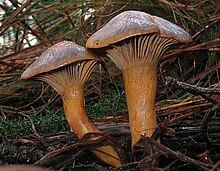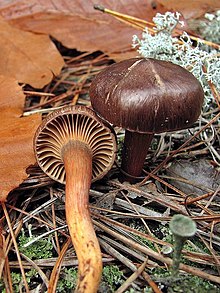Chroogomphus
| Chroogomphus | |
|---|---|

| |
| Chroogomphus rutilus | |
| Scientific classification | |
| Domain: | Eukaryota |
| Kingdom: | Fungi |
| Division: | Basidiomycota |
| Class: | Agaricomycetes |
| Order: | Boletales |
| Family: | Gomphidiaceae |
| Genus: | Chroogomphus (Singer) O.K.Mill. (1964)[1] |
| Type species | |
| Chroogomphus rutilus | |
| Synonyms | |
Chroogomphus /kroʊ.əˈɡɒmfəs/ is a genus of mushrooms commonly known as pine-spikes or spike-caps based on their shape and because they are often found growing in association with pine trees. The genus is distributed throughout the Northern Hemisphere including North America and Eurasia.
Taxonomy
These fungi are members of the family
Chroogomphus rutilus, found in Europe, is the type species.[5]
Accepted species of Chroogomphus include:[6][7]
| Image | Scientific Name | Year | Distribution |
|---|---|---|---|
| Chroogomphus albipes (Zeller) Yan C. Li & Zhu L. Yang | 2009 | Sierra Nevada | |
| Chroogomphus asiaticus O.K. Mill. & Aime | 2001 | Eastern Siberia, Nepal | |
| Chroogomphus conacytiensis Ayala-Vásquez, Martínez-Reyes, Pérez-Moreno | 2023 | Mexico | |
| Chroogomphus confusus Yan C. Li & Zhu L. Yang | 2009 | China (Yunnan) | |
| Chroogomphus filiformis Yan C. Li & Zhu L. Yang | 2009 | China (Yunnan) | |
| Chroogomphus flavovinaceus Ayala-Vásquez, Martínez-Reyes, Pérez-Moreno | 2023 | Mexico | |
| Chroogomphus fulmineus (R. Heim) Courtec. | 1988 | France | |
 |
Chroogomphus helveticus (Singer) M.M. Moser | 1967 | Czech Republic, United States, Austria, Switzerland, Czech Republic |
| Chroogomphus himalayanus K. Das, Hembrom, A. Parihar & Vizzini | 2021 | India. | |
| Chroogomphus jamaicensis (Murrill) O.K. Mill. | 1964 | United States, Dominican Republic, Jamaica | |
| Chroogomphus leptocystis (Singer) O.K. Mill. | 1964 | Canada | |
| Chroogomphus loculatus Trappe & O.K. Mill. | 1970 | United States | |
 |
Chroogomphus mediterraneus (Finschow) Vila, Pérez-De-Greg. & G. Mir | 2006 | Greece, United Kingdom, Spain |
 |
Chroogomphus ochraceus (Kauffman) O.K. Mill. | 1964 | United States, Canada |
| Chroogomphus orientirutilus Yan C. Li & Zhu L. Yang | 2009 | China (Yunnan) | |
 |
Chroogomphus pakistanicus M. Kiran & A.N. Khalid | 2020 | Pakistan |
| Chroogomphus papillatus (Raithelh.) Raithelh. | 1983 | Southern Hemisphere | |
 |
Chroogomphus pruinosus M. Kiran & A.N. Khalid | 2020 | Pakistan |
| Chroogomphus pseudotomentosus O.K. Mill. & Aime | 2001 | China (Yunnan) | |
 |
Chroogomphus pseudovinicolor O.K. Mill. | 1967 | United States |
| Chroogomphus purpurascens (Lj.N. Vassiljeva) M.M. Nazarova | 1990 | China, Russia, Germany | |
| Chroogomphus roseolus Yan C. Li & Zhu L. Yang | 2009 | China | |
 |
Chroogomphus rutilus (Schaeff.) O.K. Mill. | 1964 | Finland, Greece, Russia, South Korea |
 |
Chroogomphus sibiricus (Singer) O.K. Mill. | 1964 | Russia |
 |
Chroogomphus subfulmineus Niskanen, Loizides, Scambler & Liimat. | 2018 | Italy, Spain, Cyprus |
| Chroogomphus superiorensis (Kauffman & A.H. Sm.) Singer | 1975 | ||
 |
Chroogomphus tomentosus (Murrill) O.K. Mill. | 1964 | Canada,United States |
 |
Chroogomphus vinicolor (Peck) O.K. Mill. | 1964 | United States |
Etymology
The genus name is derived from the Greek χρω- (chroo-), meaning "skin" or "colour", and γομφος (gomphos) meaning "plug" or "large wedge-shaped nail".[8]
Description

The cap of C. rutilus is up to 10 centimetres (4 inches) in diameter and red-brown in colour. The widely spaced gills are brownish-orange and decurrent with black to brownish-yellow spores. The stalk is brownish-yellow and tapers toward the base. The flesh is orange to salmon-coloured and turns violet when chewed.
Chroogomphus vinicolor, another North American species, is likewise similar to C. rutilus, although C. vinicolor tends to be smaller. The cap color is variable in both species, with C. vinicolor being, as its scientific name suggests, more wine-colored while C. rutilus is usually more brown. The most distinctive differences between these three species are microscopic.[10][6][11]
Distribution and habitat
The genus is distributed throughout the Northern Hemisphere including North America, the Caribbean, Europe, and Asia.[5]
Ecology
Members of this genus have been thought to be
Uses
Chroogomphus rutilus, C. ochraceus, C. oregonensis, C. tomentosus, and C. vinicolor are edible[16] and may be interchangeable for culinary purposes. They are not, however, regarded as flavorful and possess neither a distinctive taste nor odor. One food writer states about C. rutilus and C. vinicolor:
They are excellent when dried, have a firm chewy texture but almost no flavor. This means you can put them in any dish without worrying about overpowering them - there's nothing to overpower! They make an excellent textural addition, though, a little crunchy, a little rubbery, very pleasant. Use them in tomato sauce as a meat substitute, or in a spicy Thai curry. You can't go wrong, because you can't taste them.[11]
Chroogomphus rutilus has been the subject of investigation as the source of
References
- ^ (Singer) O.K. Mill., Mycologia 56: 529 (1964)
- ^ "Chroogomphus" (HTML). NCBI taxonomy. Bethesda, MD: National Center for Biotechnology Information. Retrieved 3 September 2019.
- ^ (Schaeff.) O.K. Mill., Mycologia 56: 543 (1964) [MB#328192]
- PMID 17486973.
- ^ a b c Aime M, Miller OK. (2005). Proposal to Conserve the Name Chroogomphus Against Brauniellula (Gomphidiaceae). Taxon 55(1):227–228. (abstract)
- ^ a b Kuo M. (2005). The genus Chroogomphus. MushroomExpert.com.
- ^ "Search Page". Species Fungorum. Retrieved 2024-01-04.
- ISBN 978-0-19-910207-5.
- ^ Wood M, Stevens F. (2004). Chroogomphus ochraceus. MykoWeb.
- ^ Kuo M. (2005). Chroogomphus vinicolor. MushroomExpert.com.
- ^ a b Rich R. (2002). "Chroogomphus rutilis." From: Robert's wild mushroom cookbook (website).
- ^ Agerer R. (1990). Studies on ectomycorrhizae XXIV: Ectomycorrhizae of Chroogomphus helveticus and C. rutilus (Gomphidiaceae, Basidiomyetes) and their relationship to those of Suillus and Rhizopogon. Nova Hedwigia 50:1–63.
- ^ Olsson PA, et al. (2000). Molecular and anatomical evidence for a three-way association between Pinus sylvestris and the ectomycorrhizal fungi Suillus bovinus and Gomphidius roseus. Mycological Research 104:1372–1378. (abstract)
- ISBN 978-0-88192-935-5.
- ^ Assyov, Boris. "Chroogomphus helveticus". Boletales.com. Retrieved 2011-10-12.
- ISBN 978-1-55407-651-2.
Further reading
- Arora D. (1986) Mushrooms Demystified. Berkeley, CA: Ten Speed Press. ISBN 0-89815-169-4
- Breitenbach J & Kränzlin F (1991). Fungi of Switzerland 3: Boletes & Agarics, 1st Part. ISBN 978-3-85604-230-1.
- Nilsson S. & Persson O. (1977) Fungi of Northern Europe 1: Larger Fungi (Excluding Gill Fungi). Penguin Books. ISBN 0-14-063005-8
External links
 Media related to Chroogomphus at Wikimedia Commons
Media related to Chroogomphus at Wikimedia Commons Data related to Chroogomphus at Wikispecies
Data related to Chroogomphus at Wikispecies
